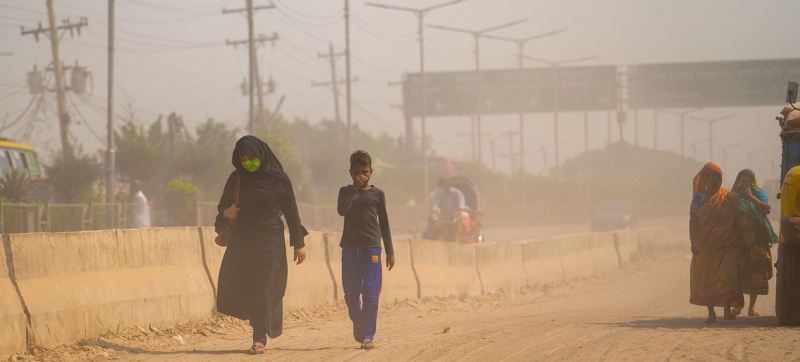
.About 40 percent of aerosols—collections of tiny particles—found in the Earth’s lower atmosphere are wind-borne dust particles. Why sand and dust storms are dangerous? Climate and Environment
Sand or dust storms turn day into night and wreak havoc on people and nature. This sight can be terrifying. The most ferocious storms are like sand tsunamis. This is recalled from the United Nations Environment Program (UNEP) on the occasion of the International Day to Combat Sand and Dust Storms, which will now be celebrated annually on July 12.
Such storms affect about 330 million people around the world, from sub-Saharan Africa to northern China and Australia. And that’s not the end.
A combination of climate change and poor land management is stripping semi-arid areas of vegetation, leading to desertification and triggering a cycle of more frequent and severe storms.
This year, the United Nations declared July 12 as the first International Day against Sand and Dust Storms. The move was intended to raise awareness of the threats posed by these squalls and stimulate international efforts to counter them.
We must not resign ourselves to a future where people living in arid and semi-arid areas are constantly plagued by dust storms
“We must not “Come to terms with a future where people living in arid and semi-arid areas are constantly affected by dust storms,” said Doreen Robinson, head of the UN Environment Program’s (UNEP) Biodiversity and Land Division. “By restoring scorched landscapes and significantly reducing greenhouse gas emissions, we can reduce the likelihood of monster storms and improve the lives of tens of millions of people.”
Our colleagues from UNEP have prepared material telling sand and dust storms, and how humanity can curb their destructive effects.
What causes sand and dust storms?
These storms occur when strong winds encounter bare or dry soil, sending large amounts of sand and dust into the atmosphere. Once in the air, sand and dust do not remain in one place, but are transported hundreds or even thousands of kilometers.
The main sources of this mineral dust are the arid regions of North Africa and the Arabian Peninsula , Central Asia and China. Australia, America and South Africa make minor but still important contributions.
Are sand and dust storms becoming more common?
Yes. Human activities such as deforestation, overgrazing and excessive water use are causing deserts to spread and increasing the likelihood of sand and dust storms. Climate change, which is bringing droughts and more extreme temperatures, is exacerbating these factors.
In some areas, the amount of dust in the desert has doubled in the 20th century, increasing the likelihood of sand and dust storms .
What is the impact of sand and dust storms?
They can have catastrophic consequences for agriculture and industry. In northern China alone, they caused nearly one billion US dollars in economic damage in just three years.
Sand and dust storms are not only dangerous for doing business, but can also trigger entire a number of respiratory diseases in humans.
About 40 percent of aerosols—collections of tiny particles—found in the Earth’s lower atmosphere are wind-borne dust particles. If particles enter the nose, mouth and upper respiratory tract, they can lead to diseases such as asthma or pneumonia.
Finer particles can penetrate even deeper, reaching the bloodstream and affecting all organs. According to a study conducted in 2014, 400,000 premature deaths were caused by exposure to dust particles.
Dust particles can also act as carriers of infectious diseases. Meningococcal meningitis is a bacterial infection of the brain, which without timely medical care is fatal in half of the cases. Incidence rates are highest in the “meningitis belt” of sub-Saharan Africa, where researchers link the disease to dust.
In addition to impacting human health, sand and dust storms can destroy crops, kill livestock, pollute machinery, and affect ground flights.
What can people do to stop sand and dust storms or limit their impact?
The phenomenon is difficult to control directly: drought or deforestation in one part of the world can lead to sand storms in another. But people can control the conditions that cause the land to dry out and dust to accumulate in the air.
In areas prone to sand and dust storms, local governments can restore the land by using scarce water more efficiently, protecting fragile topsoil, and increasing vegetation cover, including by planting native shrubs and trees. All of this helps store water in the ground, resulting in less sand and dust.
Additionally, in semi-arid regions, governments can help farmers produce food without resorting to land clearing and overgrazing, giving the soil a chance to rest and recover.
Given the connection between the problem of change climate change and looming desertification, the world must also strive to make real progress in reducing greenhouse gas emissions that fuel the climate crisis. The world is already 1.1°C warmer than it was in pre-industrial times, and as temperatures continue to rise, they will cause more droughts and create fertile ground for sand and dust storms.
Finally, as states grapple with the causes of these storms, they can continue to invest in early warning systems that warn vulnerable communities of approaching storms. This will help save lives and limit economic damage.
UN Decade on Ecosystem Restoration
UN Decade on Ecosystem Restoration Ecosystem Restoration, planned for 2021-2030 and led by UNEP and the Food and Agriculture Organization of the United Nations (FAO) together with other partners, covers terrestrial, coastal and marine ecosystems. A global call to action brings together political support, research and financial resources for a major recovery.
